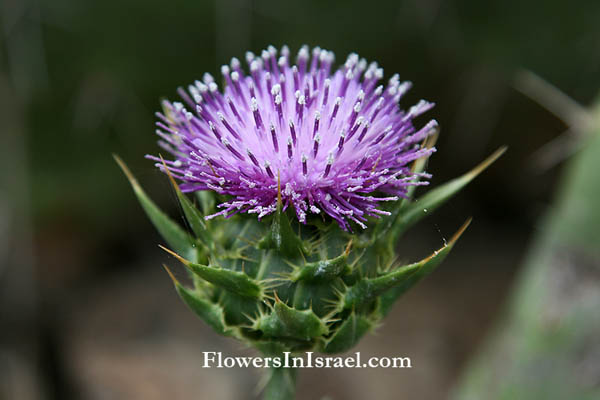Hebrew: גדילן מצוי, Arabic: خرفيش جمال, Egypt: شوك الجمل "Shouk El-Gamal"
| Scientific name: | Silybum marianum (L.) Gaertn. | |
| Scientific name: | Carduus marianus (L.) | |
| Common name: | Holy thistle, milk thistle, Our Lady's thistle | |
| Hebrew name: | גדילן מצוי | |
| Arabic name: | خرفيش جمال | |
| Egypt: | شوك الجمل "Shouk El-Gamal" | |
| Plant Family: | Compositae / Asteraceae, מורכבים |

|
| Life form: | Therophyte, annual | |
| Spinescence: | Leaves, bracts | |
| Stems: | Erect, 50-100 cm in height, grooved, branched and furrowed but not spiny; thick fleshy stems | |
| Leaves: | Alternate, rosette, entire, dentate or serrate, spinescent | |
| Flowers: | Purple, white, spinescent bracts | |
| Fruits / pods: | Black achene with a white pappus | |
| Flowering Period: | March, April, May | |
| Habitat: | Nutrient-rich soils, ruderal | |
| Distribution: | Mediterranean Woodlands and Shrublands, Semi-steppe shrublands, Shrub-steppes, Deserts and extreme deserts, Montane vegetation of Mt. Hermon | |
| Chorotype: | Med - Irano-Turanian | |
| Summer shedding: | Ephemeral |

Derivation of the botanical name: Silybum, Greek silybon, a term used by Dioscorides for thistlelike plants. Dioscorides wrote "the leaves and roots are a remedy for those that have their bodies drawne backwards." Pliny the Elder recommended the use of Silybum in the removal of bile. marianum, white-mottled leaves, referring to the story that the white marks on the leaves resulted from drops of milk shed while Mary nursed the Christ child. Carduus, thistle, the classical name. The Hebrew name: גדילן, gdilan, named after the thorns that appear to be tassels.
There are many Hebrew words which point to different kinds of prickly or thorny shrubs, like "thorns," "briers," "thistles," etc. Some call Israel 'a land of thorns.’ One of these thorns is the Silybum marianum. The plant is easy recognized because of the white veins on the leaves, which gave it the name of milk thistle. According to legend, the variegation on the leaves was caused by the virgin Mary’s milk as it ran down the leaves, hence the specific name marianum. This herb has been known in Europe and the Middle East since ancient times. According to Harold Moldenke (1909-1996), an American botanist/taxonomist (Plants of the Bible): some 125 kinds of thistles now grow in the Holy Land, lending point to the prophecies in Genesis and Hosea. Of these the commonest and the ones usually cited for these Biblical passages are Centaurea calcitrapa, Centaurea verutum, Centaurea iberica, and Silybum marianum. Dr. Michael Evenari (1904-1989), an Israeli botanist, lists Silybum marianum and Notobasis syriaca. See the list of Medicinal herbs in Israel, the parts used and their medical uses to treat various diseases. Bible Resources:


Location: Hermon Stream Nature Reserve 
|